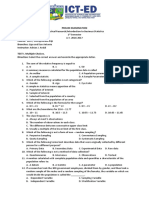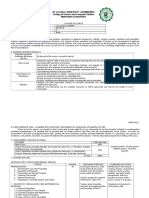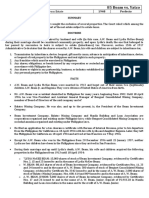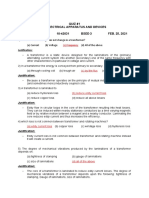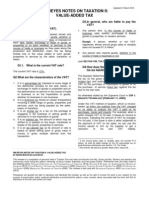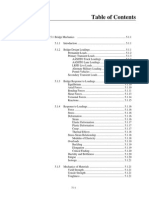0 ratings0% found this document useful (0 votes)
86 viewsProbability
The document covers basic concepts in probability and statistics, including definitions of probability, sample space, events, mutually exclusive events, independent events, and conditional probability. It provides examples to illustrate these concepts and discusses properties of the probability function. The objectives are to define key terms, illustrate properties of the probability function, and apply concepts of probability theory to solve problems.
Uploaded by
JDR JDRCopyright
© © All Rights Reserved
Available Formats
Download as PDF, TXT or read online on Scribd
0 ratings0% found this document useful (0 votes)
86 viewsProbability
The document covers basic concepts in probability and statistics, including definitions of probability, sample space, events, mutually exclusive events, independent events, and conditional probability. It provides examples to illustrate these concepts and discusses properties of the probability function. The objectives are to define key terms, illustrate properties of the probability function, and apply concepts of probability theory to solve problems.
Uploaded by
JDR JDRCopyright
© © All Rights Reserved
Available Formats
Download as PDF, TXT or read online on Scribd
You are on page 1/ 23
1st SEMESTER
STAT and PROB
Probability and Statistics are two
branches of mathematics where
probability deals with the measure of the
likelihood that an event will occur in a
random experiment and statistics deal
with the collection, analysis,
interpretation, presentation, and
organization of data.
Uses of Statistics and
Probability
• Political Science
• Psychology
• Economics
• Physical Sciences
• Tourism
• Sports
Objectives
• Define the terms related to basic probability
theory
• Illustrate the properties of a probability
function
• Define mutually exclusive events, conditional
probability and independent events.
• Apply basic concepts in probability theory
• Solve problems involving probabilities
Basic Concepts
of Probability
Statistics and Probability
SY 2019-2020
Definitions
• A random experiment is a process that can be
repeated under similar conditions but whose
outcome cannot be predicted with certainty
before hand.
• Examples:
– Tossing a coin
– Rolling a 6-sided die
– Selecting cards from a standard deck of cards
Definitions
• The sample space, denoted by Ω (Greek letter,
omega), is the collection of all possible
outcomes of a random experiment.
• An element of the sample space is called a
sample point.
• Examples:
– Tossing a coin {heads, tails}
– Rolling a die {1,2,3,4,5,6}
– Selecting a card {52 cards}
Definitions
• An event is a subset of a sample space whose
probability is defined. We say that an event
occurred if the outcome of the experiment is
one of the sample points belonging in the
event; otherwise, the event did not occur.
• Examples:
– Tossing a coin {heads, tails}
• {H}
• {T}
• {H,T}
• ϕ
Definitions
• The impossible event is the empty set, ϕ.
• The sure event is the sample space, Ω
Note: These two subsets of the sample space
will always be events.
Definitions
There are also other subsets of the sample
space.
a. If A is an event, then Ac is also an event.
b. If A and B are events, then the following are
events:
Definitions
Two events A and B are mutually exclusive
events if and only if
Examples of mutually exclusive events:
Definitions
The probability of an event A, denoted by P(A),
is a function that assigns a measure of chance
that event A will occur and must satisfy the
following properties:
Example 1
Alice, Betty and Carol are three candidates for
president in their class. Alice and Betty have the
same chances of winning. However, Carol is four
times as likely to win the election as Alice. Find
the probability of Alice or Betty winning the
election.
Properties of a Probability Function
Conditional Probability
Let A and B be two events where P(B)>0. The
conditional Probability of event A given the
occurrence of event B, denoted by P(A|B) (read
as “probability of A given B”) is
Conditional Probability
The probability that a randomly selected
student passes Trigonometry is 0.60, and the
probability that he passes Stat and Prob is 0.85.
If the probability that he passes at least one of
the two courses is 0.95,
a. What is the probability that the selected
student passes both courses?
b. What is the probability that he fails both
subjects?
Conditional Probability
c. If the selected student received a passing
grade in Trigonometry, what is the probability
that he passes Stat and Prob?
d. If the selected student received a failing grade
in Trigonometry, what is the probability that he
passes Stat and Prob?
Independent Events
Definition:
• Two events, A and B, are independent if the fact that
A occurs does not affect the probability of B
occurring.
• An event that is not affected by previous events.
Independent Events
• You flip a coin and get a head and you flip a second
coin and get a tail.
The two coins don’t influence each other.
• The probability of rain today and the probability of
my garbage being collected today;
The garbage will be collected, rain or shine.
Non-Independent Events
• You draw one card from a deck and its black and you
draw a second card and it’s black.
By removing one black card, you made the probability
of drawing a second one slightly smaller. Technically
this is called ‘sampling without replacement’.
• From a class of 18 girls and 12 boys. One student is
chosen who comes to the front of the room then
chooses a second student from those still seated.
By choosing one student in the front, the probability of
choosing a second student is then altered.
Independent Events
Independent Events
Consider the experiment of tossing a fair die twice
Define
A= event of an even number of dots on the first toss
B= event of observing more than 4 dots on the second
toss
C= event observing less than 6 dots on the first toss
Find:
Sources
PowerPoint Slides
• Cayton, Peter Julian A. (Stat 101, Random Variables and Distributions)
• Beaver, Barbara M. (Introduction to Probability and Statistics 12 edition, PPT Slides)
Course Notes
• Daquis, John Carlo P. (Stat 101, Random Variables)
Book
• Almeda, Capistrano, Sarte. (Elementary Statistics)
• Beaver, Beaver, Mendenhall (Introduction to Probability and Statistics 12 edition)
You might also like
- Thinking in Systems and Mental - Marcus P. Dawson100% (1)Thinking in Systems and Mental - Marcus P. Dawson306 pages
- Coding Club Level 3 Python Building Big Apps PDF100% (1)Coding Club Level 3 Python Building Big Apps PDF134 pages
- MATH110 Syllabus College Algebra - Doc 2014.doc Syllabus100% (1)MATH110 Syllabus College Algebra - Doc 2014.doc Syllabus4 pages
- Office of The Dean For College of Agriculture: University of Science and Technology of Southern PhilippinesNo ratings yetOffice of The Dean For College of Agriculture: University of Science and Technology of Southern Philippines4 pages
- Ed - MathMajor12 Elementary Statistics and PRobabilityNo ratings yetEd - MathMajor12 Elementary Statistics and PRobability3 pages
- Task Performance 1 Integral Calculus PrelimsNo ratings yetTask Performance 1 Integral Calculus Prelims3 pages
- Number Theory: Bachelor of Secondary EducationNo ratings yetNumber Theory: Bachelor of Secondary Education1 page
- EXERCISES FOR PARAMETRIC TESTS (Activity 1-)No ratings yetEXERCISES FOR PARAMETRIC TESTS (Activity 1-)10 pages
- Course Outline of Statistics in ManagementNo ratings yetCourse Outline of Statistics in Management4 pages
- Juan G. Macaraeg National High School Fourth Grading Period Long Quiz 5No ratings yetJuan G. Macaraeg National High School Fourth Grading Period Long Quiz 51 page
- Measure of Central Tendency Ungrouped DataNo ratings yetMeasure of Central Tendency Ungrouped Data31 pages
- Compiled by Birhan Fetene: Stat 276: Introductory Probability Lecture NotesNo ratings yetCompiled by Birhan Fetene: Stat 276: Introductory Probability Lecture Notes77 pages
- 04 Discrete and Continuous Random Variables100% (1)04 Discrete and Continuous Random Variables29 pages
- Lecture Notes: Probability and Statistics Engr. Darwin M. MurilloNo ratings yetLecture Notes: Probability and Statistics Engr. Darwin M. Murillo4 pages
- BSACC 4 Elementary Logic and Problem SolvingNo ratings yetBSACC 4 Elementary Logic and Problem Solving21 pages
- Answer Without Solution-No Points. Correct Answer With Wrong Solution Is WrongNo ratings yetAnswer Without Solution-No Points. Correct Answer With Wrong Solution Is Wrong2 pages
- Measures of Central Tendency and DispersionNo ratings yetMeasures of Central Tendency and Dispersion4 pages
- Measure of Central Tendency Grouped DataNo ratings yetMeasure of Central Tendency Grouped Data10 pages
- Welcome To Our Calculus 1 Subject: Lesson 3No ratings yetWelcome To Our Calculus 1 Subject: Lesson 314 pages
- Course Outline Title Probability and Statistics Code MT-205 Credit HoursNo ratings yetCourse Outline Title Probability and Statistics Code MT-205 Credit Hours7 pages
- Department of Education: Mathematics 7 Quarter 1 Learning Competencies Analysis On 4Cs of 21St Century SkillsNo ratings yetDepartment of Education: Mathematics 7 Quarter 1 Learning Competencies Analysis On 4Cs of 21St Century Skills22 pages
- Test of Function (Equation) and Operation On FunctionsNo ratings yetTest of Function (Equation) and Operation On Functions18 pages
- Lesson 7 - Basic Antidifferentiation RulesNo ratings yetLesson 7 - Basic Antidifferentiation Rules19 pages
- PPT-2 of Chapter 2 Multiplication Rule, Conditional Probability and Bayes TheoremNo ratings yetPPT-2 of Chapter 2 Multiplication Rule, Conditional Probability and Bayes Theorem17 pages
- File 1691289494 5000672 L2-IntroductiontoProbabilityNo ratings yetFile 1691289494 5000672 L2-IntroductiontoProbability74 pages
- MCQ Pre-Long Exam On Value Added Tax May 19, 2020No ratings yetMCQ Pre-Long Exam On Value Added Tax May 19, 20206 pages
- OCR Settles With School District in South Carolina Over Transgender DiscriminationNo ratings yetOCR Settles With School District in South Carolina Over Transgender Discrimination2 pages
- Bar Lecture Civil Law ObliCon October 3 2019 PDFNo ratings yetBar Lecture Civil Law ObliCon October 3 2019 PDF29 pages
- Province of Misamis Oriental Vs Cagayan Electric PowerNo ratings yetProvince of Misamis Oriental Vs Cagayan Electric Power4 pages
- Bank of America vs. Philippine Racing ClubNo ratings yetBank of America vs. Philippine Racing Club2 pages
- Lectures 1 - 10 Introduction To Classical Mechanics: Prof. N. Harnew University of Oxford MT 2016No ratings yetLectures 1 - 10 Introduction To Classical Mechanics: Prof. N. Harnew University of Oxford MT 2016102 pages
- New Twists in The Unfolded Protein Response: Cell BiologyNo ratings yetNew Twists in The Unfolded Protein Response: Cell Biology4 pages
- The Management of Productivity and Technology in Manufacturing PDF100% (2)The Management of Productivity and Technology in Manufacturing PDF333 pages
- Performance Assessment and Review Admin and Accounts ManagersNo ratings yetPerformance Assessment and Review Admin and Accounts Managers3 pages
- PM Reyes Notes On Taxation 2 - Valued Added Tax (Working Draft)100% (1)PM Reyes Notes On Taxation 2 - Valued Added Tax (Working Draft)22 pages
- IMPORTANT TOPICS - SCIENCE Class 10th (PRASHANT KIRAD) - Class - 10th - Most - Important - Topics (Prashant - Kirad)No ratings yetIMPORTANT TOPICS - SCIENCE Class 10th (PRASHANT KIRAD) - Class - 10th - Most - Important - Topics (Prashant - Kirad)5 pages
- Instant Racing: Just What Is Instant Racing? Racing On Previously Run Races Draws UponNo ratings yetInstant Racing: Just What Is Instant Racing? Racing On Previously Run Races Draws Upon7 pages
- MATH110 Syllabus College Algebra - Doc 2014.doc SyllabusMATH110 Syllabus College Algebra - Doc 2014.doc Syllabus
- Office of The Dean For College of Agriculture: University of Science and Technology of Southern PhilippinesOffice of The Dean For College of Agriculture: University of Science and Technology of Southern Philippines
- Ed - MathMajor12 Elementary Statistics and PRobabilityEd - MathMajor12 Elementary Statistics and PRobability
- Juan G. Macaraeg National High School Fourth Grading Period Long Quiz 5Juan G. Macaraeg National High School Fourth Grading Period Long Quiz 5
- Compiled by Birhan Fetene: Stat 276: Introductory Probability Lecture NotesCompiled by Birhan Fetene: Stat 276: Introductory Probability Lecture Notes
- Lecture Notes: Probability and Statistics Engr. Darwin M. MurilloLecture Notes: Probability and Statistics Engr. Darwin M. Murillo
- Answer Without Solution-No Points. Correct Answer With Wrong Solution Is WrongAnswer Without Solution-No Points. Correct Answer With Wrong Solution Is Wrong
- Course Outline Title Probability and Statistics Code MT-205 Credit HoursCourse Outline Title Probability and Statistics Code MT-205 Credit Hours
- Department of Education: Mathematics 7 Quarter 1 Learning Competencies Analysis On 4Cs of 21St Century SkillsDepartment of Education: Mathematics 7 Quarter 1 Learning Competencies Analysis On 4Cs of 21St Century Skills
- Test of Function (Equation) and Operation On FunctionsTest of Function (Equation) and Operation On Functions
- PPT-2 of Chapter 2 Multiplication Rule, Conditional Probability and Bayes TheoremPPT-2 of Chapter 2 Multiplication Rule, Conditional Probability and Bayes Theorem
- File 1691289494 5000672 L2-IntroductiontoProbabilityFile 1691289494 5000672 L2-IntroductiontoProbability
- OCR Settles With School District in South Carolina Over Transgender DiscriminationOCR Settles With School District in South Carolina Over Transgender Discrimination
- Province of Misamis Oriental Vs Cagayan Electric PowerProvince of Misamis Oriental Vs Cagayan Electric Power
- Lectures 1 - 10 Introduction To Classical Mechanics: Prof. N. Harnew University of Oxford MT 2016Lectures 1 - 10 Introduction To Classical Mechanics: Prof. N. Harnew University of Oxford MT 2016
- New Twists in The Unfolded Protein Response: Cell BiologyNew Twists in The Unfolded Protein Response: Cell Biology
- The Management of Productivity and Technology in Manufacturing PDFThe Management of Productivity and Technology in Manufacturing PDF
- Performance Assessment and Review Admin and Accounts ManagersPerformance Assessment and Review Admin and Accounts Managers
- PM Reyes Notes On Taxation 2 - Valued Added Tax (Working Draft)PM Reyes Notes On Taxation 2 - Valued Added Tax (Working Draft)
- IMPORTANT TOPICS - SCIENCE Class 10th (PRASHANT KIRAD) - Class - 10th - Most - Important - Topics (Prashant - Kirad)IMPORTANT TOPICS - SCIENCE Class 10th (PRASHANT KIRAD) - Class - 10th - Most - Important - Topics (Prashant - Kirad)
- Instant Racing: Just What Is Instant Racing? Racing On Previously Run Races Draws UponInstant Racing: Just What Is Instant Racing? Racing On Previously Run Races Draws Upon




